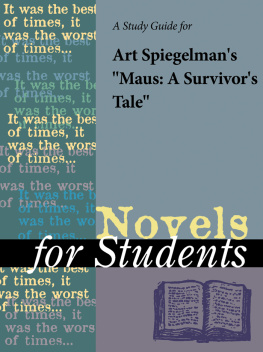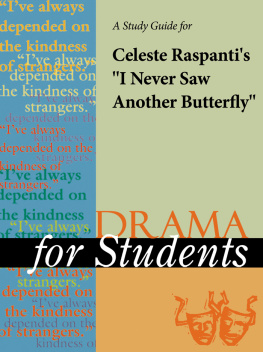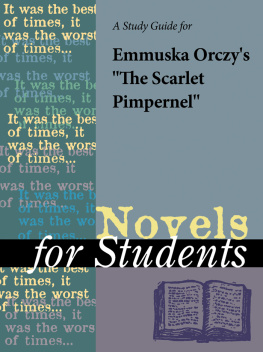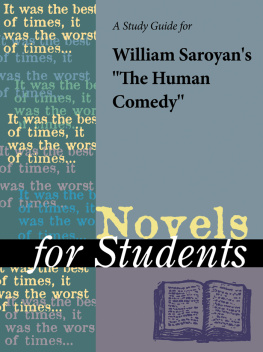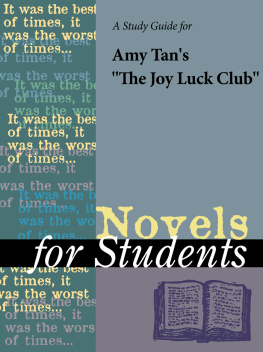TABLE OF CONTENTS
Guide
Novels for Students, Volume 35
Project Editor: Sara Constantakis
Rights Acquisition and Management: Margaret Chamberlain-Gaston, Leitha Etheridge-Sims, Kelly Quin, Aja Perales
Composition: Evi Abou-El-Seoud
Manufacturing: Drew Kalasky
Imaging: John Watkins
Product Design: Pamela A. E. Galbreath, Jennifer Wahi
Content Conversion: Katrina Coach
Product Manager: Meggin Condino
2011 Gale, Cengage Learning
ALL RIGHTS RESERVED. No part of this work covered by the copyright herein may be reproduced, transmitted, stored, or used in any form or by any means graphic, electronic, or mechanical, including but not limited to photocopying, recording, scanning, digitizing, taping, Web distribution, information networks, or information storage and retrieval systems, except as permitted under Section 107 or 108 of the 1976 United States Copyright Act, without the prior written permission of the publisher.
Since this page cannot legibly accommodate all copyright notices, the acknowledgments constitute an extension of the copyright notice.
For product information and technology assistance, contact us at Gale Customer Support, 1-800-877-4253.
For permission to use material from this text or product, submit all requests online at www.cengage.com/permissions.
Further permissions questions can be emailed to permissionrequest@cengage.com
While every effort has been made to ensure the reliability of the information presented in this publication, Gale, a part of Cengage Learning, does not guarantee the accuracy of the data contained herein. Gale accepts no payment for listing; and inclusion in the publication of any organization, agency, institution, publication, service, or individual does not imply endorsement of the editors or publisher. Errors brought to the attention of the publisher and verified to the satisfaction of the publisher will be corrected in future editions.
Gale
27500 Drake Rd.
Farmington Hills, MI, 48331-3535
ISBN-13: 978-1-4144-6698-9
ISBN-10: 1-4144-6698-6
ISSN 1094-3552
This title is also available as an e-book.
ISBN-13: 978-1-4144-7364-2
ISBN-10: 1-4144-7364-8
Contact your Gale, a part of Cengage Learning sales representative for ordering information.
Printed in the United States of America
1 2 3 4 5 6 7 14 13 12 11 10
Maus: A Survivor's Tale
Art Spiegelman
19861991
Introduction
Art Spiegelman's Maus: A Survivor's Tale is a two-volume graphic novel that documents the survival of the author's parents, both Polish Jews, during the Holocaust. Spiegelman depicts Jews as micehence the titleand Germans as cats as a metaphor for how Jews were hunted and killed in accordance with the Nazi Party's planned extermination of all European Jews during World War II. Spiegelman began work on the story as early as 1971, and he published portions of the story between 1980 and 1986 in the underground graphic journal RAW, which he edited with his wife, Franoise Mouly. The first volume of Maus, subtitled My Father Bleeds History, was published to critical acclaim in 1986; the second volume, And Here My Troubles Began, followed in 1991. Maus is as much a story about how the author's parents, Vladek and Anja Spiegelman, narrowly escaped death in Auschwitz as it is about their son's struggle to translate their personal history into a meaningful narrative and come to terms with the effect it has had on his own life.
Maus broke new ground in the graphic novel genre. Both volumes were nominated for the National Book Critics Circle Award, and in 1992 the work received a Pulitzer Prize in the Special Awards and CitationsLetters category. It also received the two highest honors in the field of graphic novels, the Eisner Award for Best Graphic Album and the Harvey Award for Best Graphic Album of Previously Published Work. Maus was arguably the first graphic novel to reach a mass audience, and it paved the way for other serious works in the genre. As a work of Holocaust literature, it has garnered praise and critical analysis on par with landmark works of the genre, including Elie Wiesel's Night and Primo Levi's Survival in Auschwitz.
Author Biography
Spiegelman was born on February 15, 1948, in Stockholm, Sweden, to Vladek and Anja Spiegelman, Polish Jews and Holocaust survivors who immigrated to the country after World War II. When Art was three, the family moved to Rego Park, a neighborhood in Queens, New York. Spiegelman was captivated by Mad magazine and Golden Age comic books as a child and attended the High School of Art and Design in Manhattan. While at Harpur College, he began working for the Topps Chewing Gum Corporation, where hecreated Wacky Packages and Garbage Pail Kids trading cards over the course of a twenty-year association with the company. When Spiegelman was twenty, he suffered a nervous breakdown and spent time in a mental hospital. Shortly afterward, his mother, who had suffered from depression for many years, committed suicide.
Spiegelman was a key figure in the alternative comicsor comix as they were affectionately knownmovement of the late 1960s and early 1970s in San Francisco. During this time he published Prisoner on the Hell Planet, an account of his mother's suicide that was later reprinted in Maus and that was also collected in 1977's Breakdowns: From Maus to Now: An Anthology of Strips. Spiegelman returned to New York in 1976 and married Francoise Mouly, a former architecture student from France. In 1980, they founded the alternative comics journal RAW, where portions of Maus first appeared. The publication of the first volume of Maus in 1986 thrust him into the spotlight as a major writer and leading graphic novelist. The second volume, published in 1991, garnered him a Pulitzer Prize and solidified his position as a major figure in Holocaust literature.
From 1991 to 2003, Spiegelman was a staff artist at The New Yorker. He contributed many covers to the magazine, the most famous of which is his September 24, 2001, black-on-black illustration featuring the barely visible silhouette of the World Trade Center twin towers. The image later became the cover of his book In the Shadow of No Towers, his graphic novel about the 9/11 attacks near his home in lower Manhattan. Though the anthologized panels that comprise the 2004 book were controversial because of Spiegelman's visceral reactions to terrorism and the wars that followed, critics praised the volume, and Time magazine listed Spiegelman as one of their Top 100 Most Influential People in 2005.
As an advocate for the graphic novel and comics in general, Spiegelman lectures frequently and has taught at the University of California at Santa Cruz and the School of Visual Arts in New York. Spiegelman and Mouly have worked together on a number of projects, including the Little Lit series, an anthology of comics for children by such authors as Lemony Snicket, Maurice Sendak, William Joyce, and Neil Gaiman.
Plot Summary
Volume I: My Father Bleeds History
The book opens in the mid-1970s with the adult Art, who is drawn as a mouse with a human body, visiting his father, Vladek, and his second wife, Mala, for dinner at their home in Rego Park, Queens. Art and his father are not close, and the tension between them is instantly apparent. Vladek and Mala have a tumultuous marriageshe complains that he is a miser, and he complains that she is a spendthrift. After dinner, Art asks his dad to recount his life before and during World War II in hopes of turning it into a graphic novel. Vladek reluctantly agrees.

